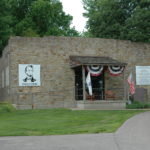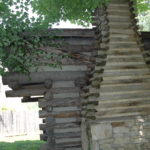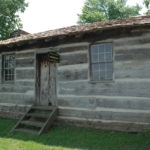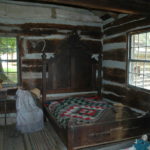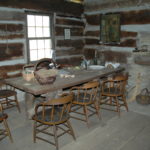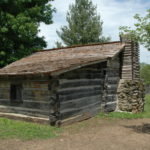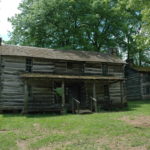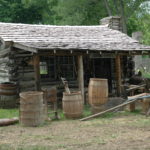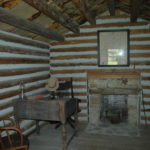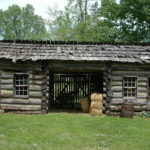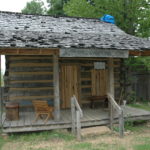In my last Chasing Abraham Lincoln post I checked in on the Lincoln’s arrival in Indiana at Sandy Creek Landing (now Grandview). Today I’ll move on to nearby Rockport, Indiana, where Lincoln began his first flatboat trip to New Orleans.
I was looking for the rock and plaque that I knew marked the spot but had no idea how to find it. As I’ve discovered during my travels, a good place to start is often the local public library. I found more than I expected at the Spencer County Public Library main branch in downtown Rockport. After meeting all of the four delightful women working the desk and genealogy departments, I spent two hours pouring through their Lincoln collection materials. I found many books and pamphlets I hadn’t known about, and photographed quite a few documents useful for my research. I even purchased a small booklet written in the 1930s that describes Sandy Creek Landing and the Lincolns. Then they showed me how to find the monument, which was only a few blocks away (not surprisingly since Rockport is tiny, harboring a population less than 2,500).
The monument commemorates one of Lincoln’s most interesting (to me) achievements – his first flatboat trip down to New Orleans – which started here in Rockport. Hooking up with Allen Gentry soon after the devastating death of his sister Sarah, Lincoln helped build the flatboat, loaded it with corn, pork, potatoes, hay, apples, and other commodities, then traveled 1,200 miles down the Ohio and Mississippi Rivers to sell their wares. While in New Orleans he was introduced to the issue that would dominate much of his later political life – slavery.
Also in Rockport is something called the Lincoln Pioneer Village and Museum. Like most artifacts of Lincoln’s life, this isn’t the original; it was built as part of Roosevelt’s “New Deal” programs in the 1930s, then renovated in the 1980s and was undergoing yet another partial renovation while I was there. The Village had opened for the season only the week before so the guy working it seemed a bit shocked to see me walk though the front door. He had grown up in Rockport and was excited to get a job curating the small museum of pioneer life.
As I walked around the village alone I stopped to watch some workers recreating a couple of the log cabins. At one point they began moving furniture back into the “Lincoln cabin” representing what the Lincoln family lived in when they had moved into the country from Kentucky. Around this time the curator came running out to ask if I wanted to see an old hearse that had been used in the 1955 movie The Kentuckian, starring Burt Lancaster, that had been filmed in part in the Village. He was so excited that I of course said yes. Unlocking a building that was temporarily being used for storage during the renovations, he led me into a dark, dusty corner where the hearse stood. He told me about the movie and how the town was honored and thrilled to have Lancaster and up-and-coming star Walter Matthau in their midst.
I rummaged around the rest of the Village, checking out the period furniture in a variety of log cabins. Some were single room, others a kind of duplex with a central porch, and still others set up as law offices, school houses, and inns. A replica of the Little Pigeon Creek Baptist Church was undergoing renovation but could be seen from the outside. The “Gentry Mansion” showed how the Gentry’s were the most prosperous family in the neighborhood (keeping in mind that “mansion” is a relative term).
Overall this was a nice glimpse into the life of pioneer villagers of Lincoln’s time. And of course the science traveler in me was thrilled to see the area where Lincoln and Allen Gentry began their flatboat touring. As I continued my tour I would see more of the frontier life during Lincoln’s most formative years in Indiana. More on that in future posts.
David J. Kent is an avid science traveler and the author of Lincoln: The Man Who Saved America, in Barnes and Noble stores now. His previous books include Tesla: The Wizard of Electricity (2013) and Edison: The Inventor of the Modern World (2016) and two e-books: Nikola Tesla: Renewable Energy Ahead of Its Time and Abraham Lincoln and Nikola Tesla: Connected by Fate.
Check out my Goodreads author page. While you’re at it, “Like” my Facebook author page for more updates!





